OSHA Inspection Series: What You Can Expect From an OSHA Inspection?
Did you recently have a workplace incident that was reported to the Occupational Safety and Health Administration (OSHA), and now, are awaiting an inspection? Here is what you can expect from an OSHA inspection.
The Occupational Safety and Health Administration (OSHA) was founded in 1970, as part of the Occupational Safety and Health Act of 1970, in which Congress created an oversight body as part of the United States Department of Labor to ensure safe and healthful working conditions for workers.
Part of OSHA’s responsibilities include conducting inspections when problems are reported, and they are tasked with enforcing the standards by providing training, outreach, education, and assistance.
If OSHA is knocking on your door, what’s your first thought? Would you be ready for an inspection? Do you have cranes in the proper working condition? What about your racking system or your fall protection equipment?
This article is the first in a series about OSHA inspections, and how its regulations help you maintain a safe workplace within various industries. In this series, we’ll be looking specifically at:
- Fall protection
- Training
- Rigging
- Cranes
- Warehouse racking
In this article, we’ll discuss
- The penalties of an OSHA violation
- Who is responsible for a violation
- How the violation can be resolved
Why Was OSHA Founded?
OSHA was founded because there were high numbers of incidents, injuries, illnesses, and deaths in workplaces across the country in the early to mid-1900s. There wasn’t a list of best practices for companies to follow, so OSHA adopted these processes and procedures.
OSHA officials have done a lot of due diligence based on industry trends and past history. If OSHA is not an expert on a topic, they will defer to some of the industry experts, including the American Society of Mechanical Engineers (ASME) and National Fire Protection Association (NFPA) among other outside agencies or associations that are experts in their respective fields.
OSHA defers to these organizations because it is what they know. This is what they dedicate all of their time and commitment to. OSHA is not going to say “Let’s try and reinvent that.” More accurately, they feel like “We’ll adopt their best practices, and that’s what we expect companies to implement and maintain.”
While OSHA does have the ability to levy fines on companies not abiding to standards of best practices, it and other regulatory agencies get a bad reputation. While companies want to put up defense measures, what OSHA is trying to do is to help send everybody home in the same condition that they arrive to work in, not generate money through the levying of fines.
OSHA’s Mission Statement is the following:
“With the Occupational Safety and Health Act of 1970, Congress created the Occupational Safety and Health Administration to ensure safe and healthful working conditions for workers, by setting and enforcing standards, and by providing training outreach, education and assistance.”
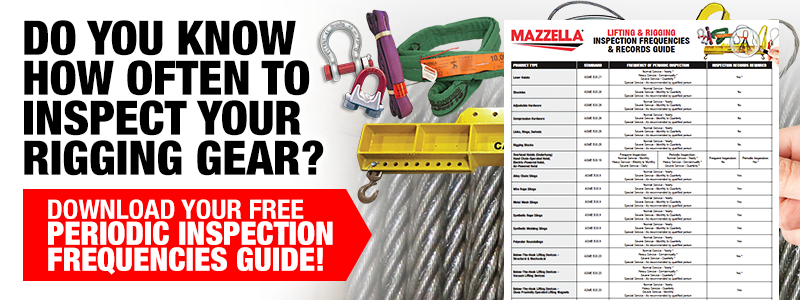
Why Would OSHA Perform an Inspection?
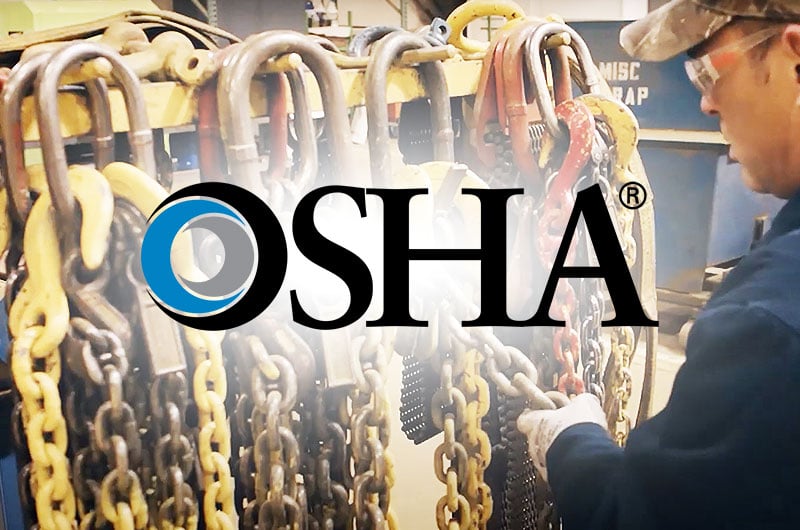
OSHA might receive a complaint about the working conditions at your company. Somebody could have submitted a written complaint or called into a hotline to report an incident or unsafe conditions on a job site. After receiving the complaint, OSHA will reach out to the company by means of either a site visit, phone call, or written notice to outline the complaint and request evidence or proof that the problem does not exist or has been remedied.
Another area OSHA may perform an inspection is when OSHA sees a trend in certain areas or industries. They will put together emphasis programs and follow up on the execution of those emphasis programs. Anytime there’s a significant incident or injury / illness that might be a cause for OSHA to come on-site, the purpose of the investigation is not just to issue a citation, but more importantly, make sure there are corrective actions to prevent any repeat incidents.
In working to make sure working environments are safe, OSHA will look for the reason(s) the incident(s) occurred, and how they can and will be corrected.
How Does the OSHA Citation Process Work?
Before any citations are issued, OSHA representatives will have a sit-down meeting to explain why they are on-site. After that opening conference, they may walk the site with your company representative(s), and when the inspection is done, recap their notes in a closing meeting with you.
Then, reports will be submitted, and they will explain:
- What inspectors found
- Why a problem occurred
- How long you have to rectify the problem
When OSHA issues a citation, it could be a notification of penalty. There could be a dollar amount associated with it.
Employers must post OSHA citations. The OSHA citation contains the:
- Standard or standards that were violated
- Length of time set for the correction
- Proposed penalties
Also, the citation will state the required next steps. For example, the employer is usually obligated to place a copy of each citation at or near the location(s) where the violation or violations occurred for three days, or until the violation is fixed. Employers must inform workers of what they have done to resolve the violation, and allow workers to review the abatement documents.
What Are the OSHA Penalties?
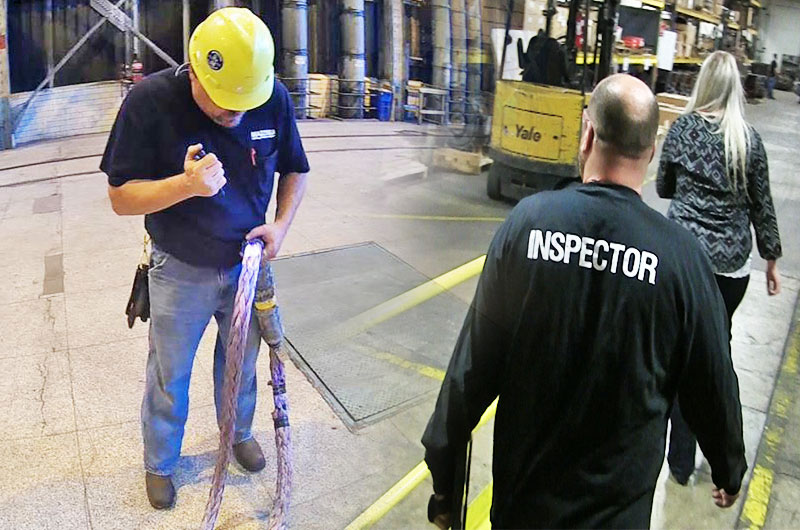
OSHA penalties are based on violation types and are adjusted each year for inflation. Here are the current maximum penalty amounts for serious, other than serious posting requirements, for failure to abate, and for willful or repeated violations.
As of February 2022, the maximum penalty amounts include:
- Serious/Other-Than-Serious/Posting Requirements: $14,502 per violation
- Failure to Abate: $14,502 per day beyond abatement date
- Willful or Repeated Violations: $145,027 per violation
How Do You Correct an OSHA Violation?
Not everything listed in a violation can be taken care of immediately. There is planning and investment, and sometimes, additional training or effort needed to properly rectify the violations.
OSHA, for example, has programs available to companies, where you can enroll with the end goal of getting the violations corrected, as well as help avoid repeated incidents in the future.
Other avenues of help include your insurance company. Insurance companies may have training, processes, and procedures in place that they can share with you to mitigate present and future risks.
Also, there are Bureaus of Workers’ Compensation or state and local municipalities that can assist. They are a great resource for you because of their information and training available. These such resources may be able to present you with a best-practice solution, where it outlines what you need to get those potential fixes in place.
Lastly, there are third-party consultants, like Mazzella, who are specific industry experts. There is a variety of tools available. You just want to make sure you pick the right ones depending on your company needs.
Who Is Responsible for Workplace Safety?
Quite simply, safety is everybody’s responsibility. First and foremost, it comes down to you making sure you’re working safe.
It’s going to start from the top of an organization with a president, CEO (chief executive officer), or another leader outlining the company’s culture and belief regarding safety and what they expect from employees. Then, you have to take ownership of your responsibilities, and if you see something that is not right, you have the duty to report it. If something does not look right, it is your right to stop work, and then, get clarity from managers or coworkers involved in the task.
One of the things Mazzella emphasizes with its employees is the stop work authority, which every employee possesses, and we expect them to use it. It’s all about continuous improvement, but again, we want to make sure everybody has that buy-in along with that drive to improve.
How Mazzella Can Help You Become OSHA-Compliant?
Ultimately, OSHA’s goal is to make sure that you’re working in a safe and healthy workplace. Their goal is not to penalize and fine you, but rather, to make sure you’re doing your part to keep safety at the front of your mind every day on the job.
If you have had an issue with OSHA citing you, Mazzella has a proven track record of helping its customers in a variety of ways. We have a diverse offering of business units to help service or replace your current equipment with OSHA-compliant gear, including:
- Lifting and rigging products
- Sling repair
- Crane ropes
- Overhead cranes and material handling
- Crane upgrades and modifications
- Overhead crane and hoist service
- Hoists and hoist repair
- Below-The-Hook lifting devices
- Fall protection
- Rigging inspection services
- Warehouse solutions
Additionally, we provide basic lifting and rigging training to any class size or jobsite.
If you require a specific lifting or rigging training course for OSHA compliance for slings, hoists and / or rigging hardware, Mazzella can assist you in creating a safe and reliable workplace.
All Mazzella trainers have been accredited by our company through training by a third-party training company (Industrial Training International, Inc.), Mazzella’s internal training program, and are trained on OSHA and ASME standards.
Call us at 800.362.4601 or click here for all of your lifting and rigging needs.
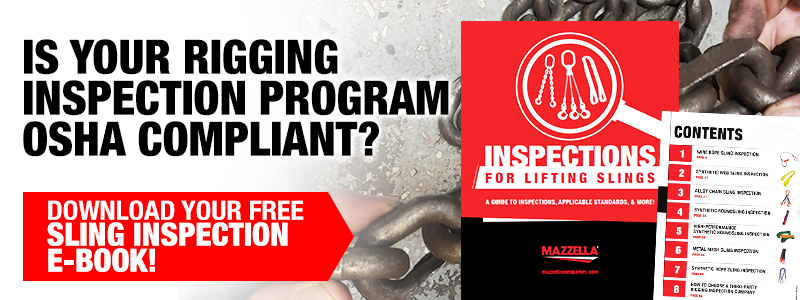

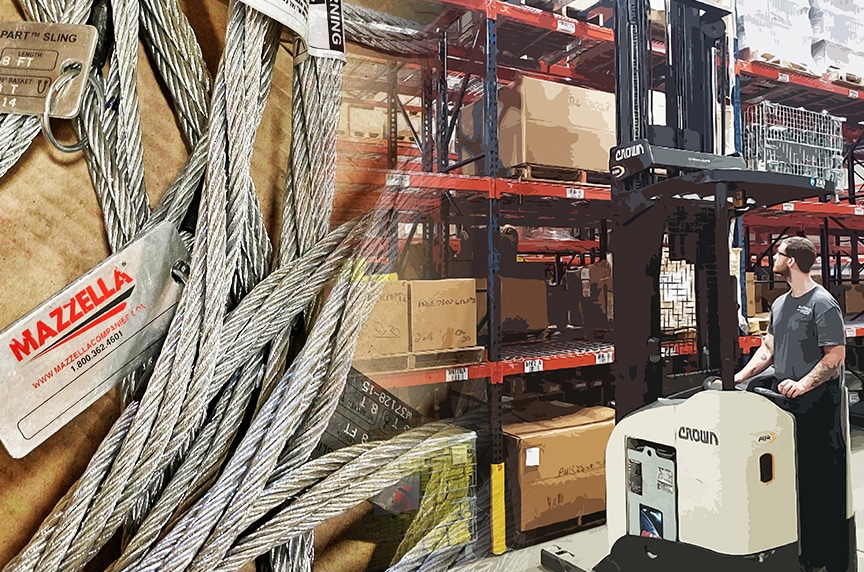
Lifting and Rigging Solutions
The Mazzella name is synonymous with quality slings – our quality slings include chain, wire rope, flat web, cordage, wire mesh, and high-performance synthetic slings. We also have one of the largest inventories of wire rope, hoists, hoist parts, pullers, rigging hardware products, and other related distributed products in the industry. Mazzella also provides wire rope assemblies – both large and small. We manufacture bridge cables, crane cables, steel mill cables and thousands of OEM assemblies.
Copyright 2022. Mazzella Companies.
